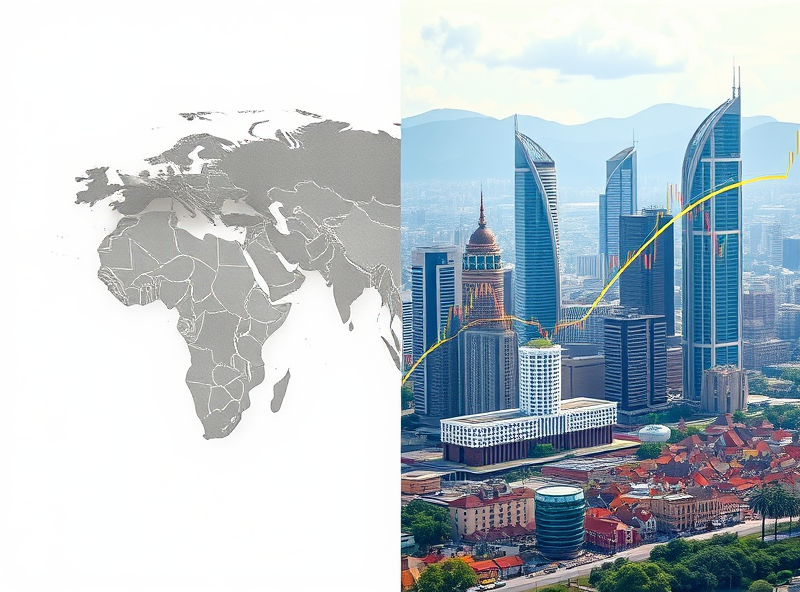
Why You Should Consider Overseas Investment: Currency Volatility & Smart Risk Strategies
Global Investment Strategies for American Investors: Maximizing Returns in a Connected World

Breaking Free from Domestic Investment Limitations
As American investors, we’re blessed with one of the world’s most robust stock markets. However, focusing solely on domestic investments might be limiting your potential for growth. Here’s why smart money is looking globally:
The Reality of U.S. Market Maturity
The American economy, while strong, faces some structural challenges that could impact investment returns:
Demographic Challenges
- Aging population affecting consumer spending patterns
- Lower birth rates impacting long-term economic growth
- Increased healthcare and social security costs
Market Saturation
- Many sectors have reached maturity with limited expansion potential
- High valuations in established companies reducing future return potential
- Increased competition making it harder for companies to achieve explosive growth
Economic Growth Trends
- U.S. GDP growth averaging 2-3% annually in recent years
- Mature infrastructure limiting major productivity gains
- Regulatory environment becoming more complex for businesses
The Global Growth Story
While the U.S. faces these challenges, other regions are experiencing exciting growth phases:
Asian Markets
- China and India representing massive consumer markets
- Technology adoption accelerating across Southeast Asia
- Infrastructure development creating investment opportunities
- Growing middle class increasing consumer spending
African Opportunities
- Young, growing populations driving economic expansion
- Natural resource wealth creating investment potential
- Technology leapfrogging traditional development stages
- Urbanization trends creating new market opportunities
Latin American Growth
- Emerging middle classes in Brazil, Mexico, and Colombia
- Resource-rich economies benefiting from global demand
- Political stability improving in key markets
- Infrastructure investment creating long-term value
Understanding Currency Dynamics: Your Secret Weapon
One of the most powerful yet misunderstood aspects of global investing is currency fluctuation. Many American investors see currency risk as a negative, but savvy investors understand it can be a significant advantage.
How Currency Movements Create Wealth
Dollar Strength vs. Weakness Scenarios
When the dollar is strong:
- Foreign investments may underperform in dollar terms
- Your purchasing power overseas increases
- It’s a great time to enter foreign markets
When the dollar is weak:
- Foreign investments provide currency gains on top of market returns
- Your international holdings become more valuable in dollar terms
- Existing global positions benefit from favorable exchange rates
Real-World Currency Success Stories
Example 1: European Investment During Dollar Weakness (2017-2020)
- Investors who held European stocks gained not only from market performance
- Additional 15-20% returns from euro strength against the dollar
- Total returns significantly exceeded U.S. market performance
Example 2: Emerging Market Currency Rebounds
- Countries like Brazil and Mexico saw currency recoveries in 2024-2025
- U.S. investors captured both market gains and currency appreciation
- Diversified portfolios outperformed purely domestic strategies
Strategic Currency Positioning
Natural Hedging Strategies
- Invest in companies that earn revenue in multiple currencies
- Choose international funds with natural currency diversification
- Consider commodity-linked investments that benefit from dollar weakness
Timing Considerations
- Monitor Federal Reserve policy changes affecting dollar strength
- Watch for political developments that impact currency relationships
- Consider dollar-cost averaging into international positions
Smart Risk Management in Global Markets
Successful global investing requires understanding and managing various types of risk. Here’s how to do it effectively:
Currency Risk Management Techniques
Diversification Approach Instead of trying to time currency movements, spread your investments across multiple currencies:
- Developed Market Currencies: Euro, British Pound, Japanese Yen, Swiss Franc
- Emerging Market Currencies: Chinese Yuan, Indian Rupee, Brazilian Real
- Commodity Currencies: Canadian Dollar, Australian Dollar, Norwegian Krone
Hedged vs. Unhedged Investments
When to Choose Hedged Investments:
- Short-term investment horizons (1-3 years)
- Conservative risk tolerance
- Concerns about specific currency weakness
- Need for predictable returns
When to Choose Unhedged Investments:
- Long-term investment horizons (5+ years)
- Desire for additional return potential
- Belief in currency diversification benefits
- Willingness to accept volatility for higher returns
Geographic Risk Assessment
Political Stability Factors
- Democratic institutions and rule of law
- Property rights protection
- Regulatory transparency and consistency
- Historical political transitions
Economic Fundamentals
- GDP growth trends and sustainability
- Inflation rates and central bank credibility
- Government debt levels and fiscal policy
- Trade relationships and economic dependencies
Institutional Support for Global Investing
Major financial institutions and regulators are actively encouraging international diversification. Understanding why can help inform your strategy:
Regulatory Perspective
Systemic Risk Reduction
- Regulators recognize that diversified portfolios create more stable financial systems
- International investing reduces correlation risk during domestic downturns
- Global exposure helps protect against country-specific economic shocks
Capital Flow Benefits
- International investment helps balance trade relationships
- Diversified capital flows strengthen currency stability
- Global integration improves overall market efficiency
Institutional Advantages
Enhanced Due Diligence
- Major institutions provide extensive research on international markets
- Professional analysis of political and economic risks
- Access to management teams and local market insights
Cost Efficiency
- Institutional scale reduces transaction costs for international investing
- Professional currency hedging at lower costs than individual investors
- Diversified fund structures spreading fixed costs across many investors
Practical Implementation Strategies
Building Your Global Portfolio
Core Holdings (40-60% of international allocation)
- Developed market index funds (Europe, Japan, Australia)
- Large-cap international stocks with strong fundamentals
- Established multinational companies with global revenue
Growth Opportunities (20-30% of international allocation)
- Emerging market index funds or ETFs
- Technology companies in developing markets
- Consumer discretionary stocks in growing economies
Specialized Exposure (10-20% of international allocation)
- Sector-specific international funds (technology, healthcare, energy)
- Small-cap international opportunities
- Frontier market exposure for aggressive growth
Investment Vehicle Selection
Exchange-Traded Funds (ETFs)
- Low cost and high liquidity
- Easy diversification across regions and sectors
- Tax efficiency for U.S. investors
Mutual Funds
- Professional management and research
- Access to closed markets and specialized strategies
- Automatic reinvestment and rebalancing
Individual Stocks
- Direct ownership of international companies
- Ability to target specific opportunities
- Higher potential returns with increased risk
American Depositary Receipts (ADRs)
- Trade on U.S. exchanges in dollars
- Simplified tax reporting and dividend collection
- Access to major international companies
Tax Considerations for Global Investors
Understanding Tax Implications
Foreign Tax Credits
- Reduce U.S. tax liability for foreign taxes paid
- Apply to dividends and capital gains from international investments
- Require proper documentation and filing
Currency Gain/Loss Recognition
- Currency fluctuations can create taxable events
- Important for individual stock holdings
- Less relevant for fund investments
Tax-Efficient Strategies
Asset Location Optimization
- Hold international bonds in tax-deferred accounts
- Keep growth-oriented international stocks in taxable accounts
- Consider Roth IRA for long-term international growth investments
Monitoring and Rebalancing Your Global Portfolio
Key Metrics to Track
Performance Measurement
- Compare returns to appropriate international benchmarks
- Monitor currency impact on total returns
- Assess risk-adjusted performance using Sharpe ratios
Risk Assessment
- Track correlations between domestic and international holdings
- Monitor country and currency concentration
- Assess overall portfolio volatility and drawdowns
Rebalancing Strategies
Time-Based Rebalancing
- Quarterly or annual rebalancing schedules
- Maintains target allocation percentages
- Disciplined approach to buying low and selling high
Threshold-Based Rebalancing
- Rebalance when allocations drift beyond target ranges
- More responsive to market movements
- Potentially more tax-efficient timing
Future Trends in Global Investing
Emerging Opportunities
Technology Integration
- Fintech developments in emerging markets
- Digital currency adoption creating new investment categories
- Artificial intelligence and automation transforming global industries
Sustainability Investing
- ESG considerations becoming standard in international markets
- Climate change creating new investment opportunities
- Sustainable development goals driving capital allocation
Demographic Trends
- Aging populations in developed markets creating healthcare opportunities
- Young populations in emerging markets driving consumption
- Urbanization trends creating infrastructure investment needs
Conclusion: Your Global Investment Journey
Global investing isn’t just about diversification—it’s about positioning yourself to benefit from the world’s growth and opportunity. As an American investor, you have access to the best tools, research, and investment vehicles to build a truly global portfolio.
The key to success is starting with a clear strategy, understanding the risks and opportunities, and maintaining a long-term perspective. Currency fluctuations, political developments, and economic cycles will create volatility, but they also create opportunities for patient, informed investors.
Remember, global investing is a marathon, not a sprint. Start with broad diversification through low-cost index funds, gradually add more specialized exposure as you gain experience, and always maintain appropriate risk management.
The world economy offers tremendous opportunities for growth, income, and diversification. By thinking globally while acting strategically, you can build a portfolio that’s prepared for whatever the future brings.
Are you ready to expand your investment horizon globally? What international markets or strategies interest you most? Share your thoughts in the comments below—we’d love to hear about your global investment goals and help you develop a winning strategy!
Disclaimer: This article is for educational purposes only and should not be considered as investment advice. International investing involves additional risks including currency fluctuations, political instability, and different regulatory environments. Past performance does not guarantee future results. Always consult with qualified financial professionals before making investment decisions, especially regarding international markets.







